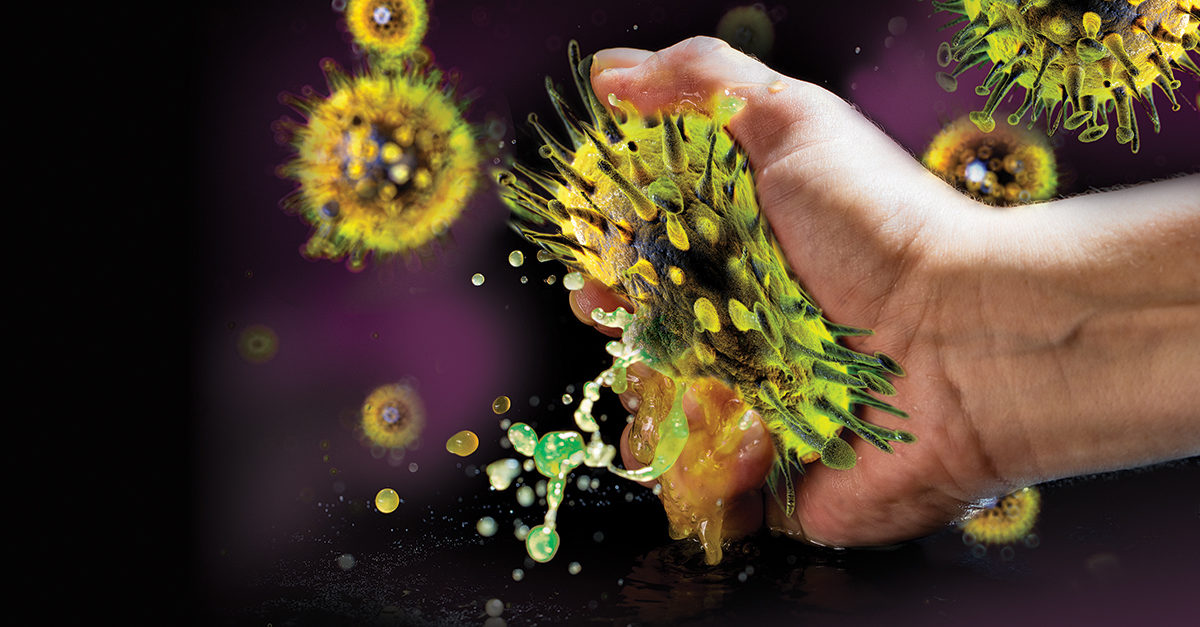 Steve Attman is co-CEO of ACME Paper and Supply Company, a regional distribution company for the mid-Atlantic markets and one of the nation’s largest providers of institutional cleaning products and systems. With more than 40 years of experience in disinfection, Attman is an expert in cleaning practices that have proven to reduce health care-acquired infections (HAIs). Attman has received the Association for Healthcare Environment’s (AHE) Seal of Review and Recognition as part of the Healthy Measures program and is a member of the Clorox Distributor Council. Attman works with hospitals, schools, airports, and other high-traffic facilities across the country to deliver the most effective germ-cleaning options
Steve Attman is co-CEO of ACME Paper and Supply Company, a regional distribution company for the mid-Atlantic markets and one of the nation’s largest providers of institutional cleaning products and systems. With more than 40 years of experience in disinfection, Attman is an expert in cleaning practices that have proven to reduce health care-acquired infections (HAIs). Attman has received the Association for Healthcare Environment’s (AHE) Seal of Review and Recognition as part of the Healthy Measures program and is a member of the Clorox Distributor Council. Attman works with hospitals, schools, airports, and other high-traffic facilities across the country to deliver the most effective germ-cleaning options
Not too long ago, if people became ill with an infection caused by bacteria, they simply took a medication prescribed by their physician to kill the germ. Professionals tasked with cleaning physician’s offices, hospitals, and other facilities teeming with pathogens gave the buildings a thorough cleaning and disinfection to stop the spread of germs.
Today, some bacteria have become immune to the antibiotics that once killed them, making these pathogens a bigger threat to the general population. Germs are also becoming more difficult to eliminate with previous cleaning methods, allowing them to spread and infect more people. This is the era of the superbug.
Today, superbugs cause twice as many deaths in the United States as they did six years ago. In fact, approximately 2.8 million people are infected with a superbug every year—35,000 die as a result, according to the U.S. Centers for Disease Control and Prevention (CDC).
CMM recently asked disinfection expert Steve Attman about the emergence and treatment of superbugs and how the cleaning industry can adapt and stay ahead of new threats.
How would you define a superbug?
Superbugs are strains of bacteria or fungi-spores that are resistant to most of the antibiotics commonly used today. Resistant bacteria that cause pneumonia, urinary tract infections, and skin infections are just a few of the dangers we now face. Antibiotic resistance is a naturally occurring phenomenon that can be slowed, but not easily stopped. Over time, bacteria adapt to the drugs designed to kill them and change to ensure their survival. This makes previously standard treatments for bacterial infections less effective, and in some cases, ineffective.
People may accelerate the emergence and spread of antibiotic-resistant bacteria by:
- Using or misusing antibiotics
- Having poor infection prevention and control practices
- Living or working in unsanitary conditions.
How have infection control practices changed since the emergence of superbugs?
While the main tenants of infection control—breaking the chain of infection—are always relevant, health care and cleaning professionals are continually evolving their practices based on emerging science and technology. Furthermore, as the line between public and private spaces is increasingly blurred, infection control efforts need to extend beyond health care settings and into other shared communal spaces and commercial facilities from schools to office buildings and beyond.
The cleaning industry understands that infection prevention is multifaceted. The medical and public community need a heightened focus on proper handwashing and continued antibiotic stewardship to prevent additional superbugs. Environmental services professionals need to follow a robust cleaning and disinfection program.
While a superbug can be deadly once acquired, proper cleaning and disinfection processes can prevent and control the spread of these potentially deadly pathogens. The CDC recommends that professional cleaners use EPA List K-approved products to effectively combat the superbugs of today and the emerging threats of tomorrow. You can find this list on the U.S. Environmental Protection Agency’s website.
The cleaning industry also is paying increased attention to the environmental hygiene of facilities. This includes using faster-acting disinfectants like hydrogen peroxide that have efficacy of one minute versus some past products that can take up to 10 minutes. Hydrogen peroxide wipes can deliver a quicker, greener, safer, and more effective cleaning performance compared to other types of wipes. The industry also is increasing its use of sporicides to ensure the most aggressive efficacy against all bacteria and spores, including Clostridium difficile (C. diff) spores.
New technologies that keep environments cleaner include electrostatic disinfection and sanitizing applicators. These methods envelop a surface from top to bottom, allowing it to stay wet long enough to kill germs, unlike some traditional quat/alcohol methods that often don’t stay wet long enough to eliminate the bacteria. An October 2019 study in PubMed Central® found that applying a sporicidal disinfectant with an electrostatic sprayer on wheelchairs, portable equipment, waiting room chairs, and other items frequently contaminated with C. diff provided a rapid and effective means to reduce spore contamination on these surfaces.
Other emerging products and systems that will continue the fight against the superbugs include self-disinfecting surfaces and copper-infused linens.
Hand hygiene is the single most effective way to prevent the spread of antibiotic-resistant organisms, especially when practiced in a culture of compliance. Other methods that go a long way in effectively managing the spread of superbugs include active surveillance of infections and awareness of antibiotic resistance patterns in a facility or community, use of personal protective equipment (PPE) such as gloves, gowns, and face masks, and use of other infection barriers such as isolation until a patient’s infection culture comes back negative.
C. diff and Candida auris are among the superbugs on the CDC’s urgent threat list. What cleaning and disinfection best practices can eliminate these pathogens?
As referenced earlier, the CDC recommends EPA List K-approved products for eliminating C. diff and Candida auris (C. auris). Clean affected surfaces with products that are effective against multidrug-resistant bacteria in biofilm, then follow the cleaning with enhanced disinfection using electrostatic application to reduce the risk of surfaces becoming a reservoir for continued pathogen transmission. The clinical efficacy of infection prevention programs depends on a systematic approach that combines better chemistries with better delivery methods.
Overall, the CDC recommends three approaches to combating superbugs:
- Developing new drugs to which the bacteria and fungi have not developed resistance
- Implementing antibiotic stewardship protocols within health care facilities. (Antibiotic stewardship refers to a set of strategies to improve the use of antibiotics to enhance patient outcomes and reduce resistance to antibiotics.)
- Preventing the development of infections by killing pathogens on environmental surfaces through proper surface disinfection. Proper disinfection not only helps to prevent infections, it also stops them from transmitting from surfaces to people, as well as within or between facilities.
Are there other superbugs you feel are a threat to the health of people in the U.S. and worldwide? What is being done or can be done to control these pathogens?
The CDC’s second “Antibiotic Resistance Threats in the United States” report, released in November, identifies a total of 18 antibiotic-resistant threats. C. auris is one of the biggest emerging threats; 60% of those who contract this fungal infection die. A majority (90%) of C. auris infections are resistant to one antifungal drug, 30% are resistant to at least two.
Other urgent threats listed in the report include, Barbapenem-resistant Acinetobacter, Carbapenem-resistant Enterobacteriaceae, drug-resistant Neisseria gonorrhoeam, and C. diff. One out of 17 people who contract C. diff die.
Hepatitis A has made a resurgence, with over 20,000 people in the United States becoming infected between the end of 2017 and November 2019. Hepatitis A is vaccine preventable, and most of the cases being seen are in the country’s homeless population. As this illness is spread through contact with feces, better attention to restroom and hand-washing facilities for this population is paramount.
While the overuse of antibiotics in people has become more recognized, attention is now turning to antibiotic use in animals and on crops. The use of fungicides on crops has led to increased resistance to antifungal agents.
Continued research and education are vital to minimize the impact of deadly superbugs. Organizations are taking a lead in developing best practices for cleaning protocols. One example is a program that provides a scorecard-based site analysis to establish a baseline from which participants can measure progress. Using the information from the analysis, the program develops an action plan and implementation process for proper surface disinfection and hand hygiene.
What are some common misconceptions people have about superbugs? How are these beliefs harmful?
Many people mistakenly believe that superbugs and antibiotic resistance are only issues within health care settings. However, this is no longer the case. Once mainly detected in hospitals and other medical care facilities, variants of antibiotic-resistant infections, notably C. diff and Methicillin-resistant Staphylococcus aureus (MRSA), have increased in people who were not exposed to health care settings. The CDC found almost a third of new C. diff cases annually are contracted outside of health care settings.
Another myth states that if an organism develops a resistance to antibiotics, then it is also resistant to disinfectants. In truth, disinfectants continue to be the best way to kill antibiotic-resistant organisms.
The belief that superbugs are most easily spread by ill individuals also is not true. These superbugs commonly move around facilities via dirty hands, contaminated equipment, and poorly cleaned restrooms.
It is imperative to combat these myths and misconceptions with facts, so we are all working together from the same playbook to reduce the spread of superbugs.
While scientists and physicians continue to develop new methods and drugs to combat these deadly bugs, we all need to be diligent in following proper, approved cleaning and disinfection protocols.
Looking ahead 10 or 20 years, what can we expect from superbugs if we don’t control them now?
We are already in a post-antibiotic era where even simple infections can be life-threatening. If we do not act to control superbugs now, the number of life-threatening infections will only continue to multiply.
Conversation about antibiotic resistance and stewardship needs to take center stage to combat this epidemic. Overuse and misuse of antibiotics needs to stop. Education, worldwide, is paramount to making this happen.



